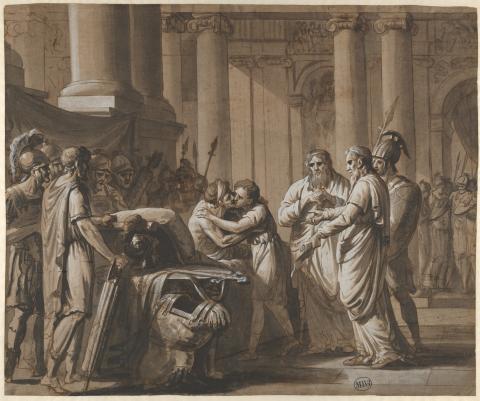Emma Vanderpool
November 20, 2017
The pitfalls facing intermediate Latin students as they move from a basic knowledge of forms and the simplified Latin of textbooks to actually reading Latin are well-known. It’s not just the artful word order or sophisticated grammar of classical texts. As Kenneth Kitchell emphasized in a well-known article (Kitchell 2000), the geographical and cultural knowledge required can baffle even the student well trained in verb forms, case usage, and syntax. Then there is the well-known tendency of students themselves to ignore low-hanging fruit, to spurn the solicitously extended helping hand in the form of commentaries on their Latin texts, notes specifically designed to help them surmount these difficulties. What can be done?
In 2016 Matthew Katsenes and I developed an online Latin reading environment for a commonly used transposal text, Eutropius’s Breviarium of Roman History. We christened it Eutropi.us and gave it a classroom trial in the Latin III class at Moultonborough Academy, a small public high school in rural New Hampshire. The choice of Eutropius was determined partly by the approachability of his Latin. His schematic account of Roman history would also be helpful background for high school students preparing to read the Advanced Placement Latin syllabus (which covers Caesar and Vergil) or other Republican and golden age authors. In the process, we set out to explore the interaction between text and technology and the consumption of electronic texts.
Eutropius provides enticing opportunities for the commentator. Compared to authors such as Vergil and Ovid, relatively little work had been done with his text. (See Beyer 2009 and 2015 and Masters 2012 for the most current print commentaries, and Bird 1993 for the most recent translation.) We had ample room to experiment in terms of the commentary. As Dale Grote notes in his introduction to Beyer’s translation, Eutropius’s style “is lucid and simple, without being insultingly juvenile” and “challenges emerging Latin students without annihilating their confidence” (Beyer 2009, p. ix). This style employs a restricted vocabulary, straightforward syntax, and familiar grammatical constructions – a perfect recipe for transitioning Latin students.
We curated the selections in order to help contextualize them for the AP Latin Exam. Our excerpts cover the period 113 to 63 BCE, from the Jugurthine War to the Catilinarian Conspiracy. Eutropius’s abbreviated history by no means guarantees a full understanding of this turbulent time period, yet it does provide an opportunity to, at the very least, introduce key players and events, and to remedy some of the cultural and geographical deficits Kitchell identifies.
We first surveyed all digital classical texts and commentaries online to get an idea of what the possibilities and pitfalls might be. We then built in what seemed to us to be key features for a transitional reader:
- “Chunking”: We broke larger paragraphs into smaller sections to reduce scrolling (which is believed to reduce student retention of information), and used indenting to make sense units clearer. The system is graduated so that as the student progresses, the highlighted sense units become progressively longer and the indenting becomes less aggressive.
- Dynamic Texts: Optional highlighting of the sense units can be navigated through the numbers at the bottom of the text and are meant to guide the students’ eyes through the text. The system is based on Kitchell and Sienkewicz’s innovative typography in their Legamus series, but the digital medium allows for the progressive highlighting of individual sense units as the student reads.
- Interactive Commentary: While the student navigates through the sense units, the corresponding commentary lower on the screen is also highlighted. This system is not meant to engender an over-reliance on the notes, but to train students to look to the commentary for guidance. Grammatical references are also included, and are customizable to a range of elementary textbooks. In order to allow for a variety of teaching styles, no specific grammatical explanations are included; instead, students are directed back to the familiar pages of their own textbook.
- Clickable, Curated Vocabulary: The vocabulary is not immediately apparent on the page. Instead, students are able to click and define specific words, which are highlighted in blue. The vocabulary glosses are based on Paul B. Diederich's Basic Vocabulary of Ancient and Medieval Latin, and Quizlet flashcards are available.
- Background Materials: brief biographical and historical essays attempt to address any cultural and historical deficits, and include links to the appropriate entries on Attalus, William Smith’s A Dictionary of Greek and Roman biography and mythology at Perseus, and Wikipedia. To help students keep track of the main events, we included an interactive timeline, created through Timeline JS.
- Teaching Materials: grammatical and vocabulary activities accompany the text along with an example project assignment.
Born digitally, this commentary seeks to explore the interaction of text and technology and to push the current boundaries. During our classroom trial, we found that, more than anything, the inclusion of technology and these features (e.g., hyperlinks and highlighted sense units) placed a greater sense of agency and choice into the hands of students. It helped to ease that transition into this authentic Latin text and into the turbulent years leading to the fall of the Roman Republic.
(Header Image: "Scene from Roman History, depicting a Youth receiving Armor from a Dying Man." Late 18th to mid-19th century, Mathieu-Ignace van Bree. Metropolitan Meseum of Art 2013.533. Licensed under CC0 1.0. Public Domain.)
Reference
Kitchell, K. 2000. “Latin III’s Dirty Little Secret: Why Johnny Can’t Read Latin.” New England Classical Journal 27.4: 206–226.
Authors


